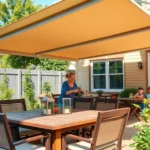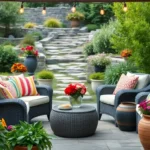Transform your outdoor space with stunning paver walkways that blend functionality with eye-catching design. We’ve discovered that the right walkway doesn’t just connect point A to point B – it creates a beautiful journey through your industry while boosting your home’s curb appeal and property value.
Whether you’re dreaming of a rustic cobblestone path winding through your garden or a sleek modern walkway leading to your front door, pavers offer endless possibilities. We’ll explore creative patterns, material combinations, and design strategies that’ll make your neighbors stop and stare.
From budget-friendly DIY projects to luxurious statement pieces, we’ve gathered the most inspiring paver walkway ideas that work for every style and budget. Get ready to discover how these versatile building blocks can transform your ordinary pathway into an extraordinary outdoor feature that reflects your personal taste.
Classic Brick Paver Walkways for Timeless Appeal
Brick paver walkways remain the gold standard for homeowners seeking enduring elegance in their industry design. We’ve witnessed countless trends come and go, but brick’s natural charm and durability continue to deliver exceptional curb appeal across all architectural styles.
Traditional Red Brick Patterns
Traditional red brick walkways offer unmatched versatility that complements both colonial and contemporary home designs. We recommend starting with the classic running bond pattern, which creates clean lines and visual flow while using standard rectangular bricks laid end to end with staggered joints.
Stretcher bond patterns work exceptionally well for straight walkways, creating a streamlined appearance that guides visitors naturally toward your entrance. Stack bond layouts provide a more formal look with bricks aligned in perfect rows, though we suggest adding border courses to prevent a monotonous appearance.
Running bond remains our top choice for curved pathways since the staggered joints accommodate direction changes smoothly. We often specify 4×8 inch standard bricks for these installations, as they’re easier to cut and fit around industry features like trees or garden beds.
Herringbone and Basket Weave Designs
Herringbone patterns transform ordinary walkways into stunning focal points that catch the eye from every angle. We create these distinctive designs by laying rectangular bricks at 45 or 90 degree angles, forming zigzag patterns that add incredible visual texture to any outdoor space.
Classic herringbone uses bricks positioned at 45 degree angles, creating diamond shapes that make narrow walkways appear wider. Straight herringbone features bricks at 90 degree angles, producing a more subtle pattern that works beautifully with traditional architecture.
Basket weave patterns offer another timeless option that mimics woven fabric through alternating brick orientation. We typically arrange these in pairs of bricks laid horizontally next to pairs positioned vertically, creating squares that repeat across the entire walkway surface.
Double basket weave designs use four bricks instead of two in each section, producing larger pattern blocks that work better on wider walkways. We recommend this variation for paths exceeding 4 feet in width to maintain proper scale and visual balance.
Mixing Brick Colors for Visual Interest
Color variation elevates basic brick walkways into custom design features that reflect your personal style preferences. We achieve stunning results by combining traditional red bricks with complementary colors like buff, brown, or charcoal to create unique patterns and borders.
Border accents using contrasting brick colors define walkway edges while adding sophisticated detail to the overall design. We often use darker bricks like chocolate brown or charcoal as borders with lighter red or buff bricks filling the main walkway area.
Random color mixing creates organic, aged appearances that work particularly well in cottage garden settings. We recommend using a 60/30/10 ratio when combining three colors, with the dominant color comprising 60%, secondary color at 30%, and accent color at 10% for balanced visual appeal.
Banded patterns using alternating rows of different colored bricks produce dramatic striped effects across the walkway surface. We space these bands 12 to 18 inches apart to create rhythm without overwhelming the overall design composition.
Natural Stone Paver Walkways for Rustic Charm
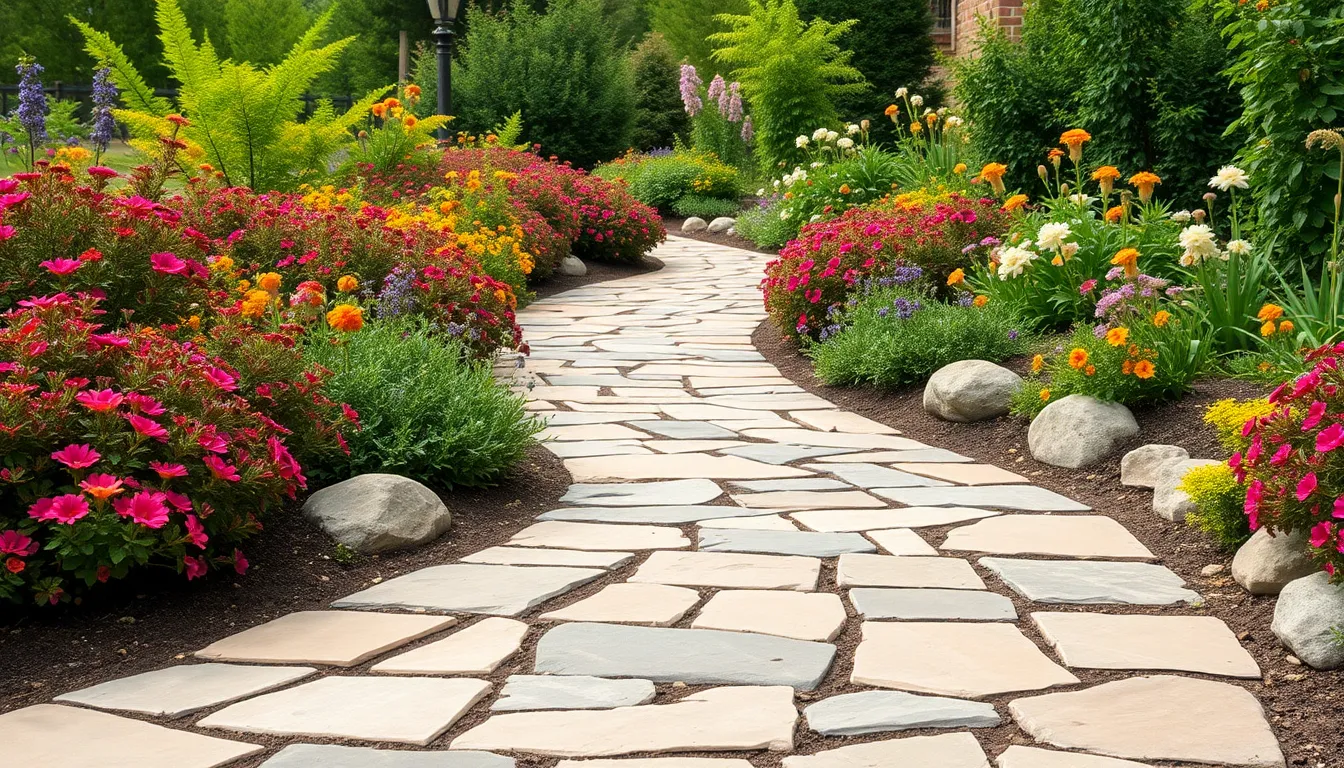
Natural stone pavers bring an authentic, weathered beauty that transforms ordinary walkways into stunning industry features. We’ve found these materials create the perfect foundation for rustic charm while offering exceptional durability.
Flagstone Pathway Designs
Flagstone creates uniquely shaped walkways that blend seamlessly with natural landscapes. Available in various colors and sizes, these stones are laid in irregular patterns that highlight each stone’s natural characteristics. We recommend choosing flagstone pieces that vary in dimension to achieve the most organic appearance.
Proper installation ensures these pathways last for decades with minimal maintenance requirements. Surrounding your flagstone walkway with native shrubbery and colorful flowers adds visual appeal while softening the stone edges. These design elements work together to create a cohesive outdoor space that feels both intentional and naturally evolved.
Bluestone Walkway Options
Bluestone offers exceptional durability and attractive coloring that complements both traditional and contemporary landscapes. We typically install bluestone as large flat slabs for a clean modern look or as irregular pieces for rustic appeal. This versatile flagstone type maintains its color well over time and resists weathering in various climates.
Large bluestone slabs create dramatic stepping stones that span wider distances between plantings. Smaller irregular pieces allow for tighter joints and more intricate pathway curves. We often combine bluestone with complementary materials like river rock or crushed stone to enhance drainage and visual texture.
Irregular Stone Pattern Ideas
Irregular stone patterns use flagstone or slate cut into non uniform shapes for a natural artisanal appearance. These patterns are ideal for creating visually ever-changing pathways that feel hand crafted rather than manufactured. Slate pavers contribute to contemporary aesthetics while remaining highly durable even though their heavier weight and higher cost.
Interlocking irregular designs offer modern twists on traditional stone laying techniques. We design these patterns to include varying stone sizes that create natural flow lines directing foot traffic. Split face pavers with their rough uneven texture mimic naturally split stone while providing consistent thickness for easier installation than fieldstone alternatives.
Modern Concrete Paver Walkways for Contemporary Homes

Contemporary homes benefit greatly from the clean lines and sophisticated appeal that modern concrete pavers provide. These versatile materials offer endless design possibilities while maintaining the minimalist aesthetic that defines modern architecture.
Large Format Concrete Slabs
Wide concrete pavers transform ordinary walkways into striking architectural features that complement contemporary home designs. Most home centers stock these impressive slabs, making them accessible for various project budgets and timelines. Installation becomes straightforward when you set these pavers in coarse paving sand for optimal stability and longevity.
Straight line placement creates a bold, linear pathway that emphasizes the home’s geometric features. Staggered arrangements add ever-changing visual movement while maintaining the clean aesthetic modern homes require. Large format slabs reduce the number of joints in your walkway, creating smoother transitions and easier maintenance over time.
Geometric Pattern Designs
Linear geometric patterns using straight lines and right angles establish the minimalist foundation that modern architecture demands. Contemporary design principles shine through when you incorporate these clean, structured layouts into your walkway planning. Right angles and precise measurements create visual harmony between your pathway and home’s architectural elements.
Mixed paver sizes within geometric arrangements add sophisticated visual interest without compromising the streamlined appearance. Different colors can enhance these patterns while maintaining the cohesive look that contemporary homes require. Geometric designs work particularly well when they echo the home’s existing architectural features like windows, rooflines, or landscaping elements.
Textured Concrete Paver Options
Smooth faced pavers deliver the sleek, polished appearance that contemporary designs celebrate most effectively. These refined surfaces reflect light beautifully and create seamless transitions between indoor and outdoor living spaces. Contemporary homeowners often choose smooth options for their ability to complement modern furnishings and architectural details.
Aggregate faced pavers include exposed materials that provide subtle texture while maintaining modern appeal. Natural aggregate surfaces offer slip resistance without sacrificing the clean lines that contemporary design requires. Interlocking varieties create puzzle like patterns that allow customization through different colors and sizes, giving you flexibility in achieving your desired aesthetic outcome.
Permeable Paver Walkways for Eco-Friendly Solutions
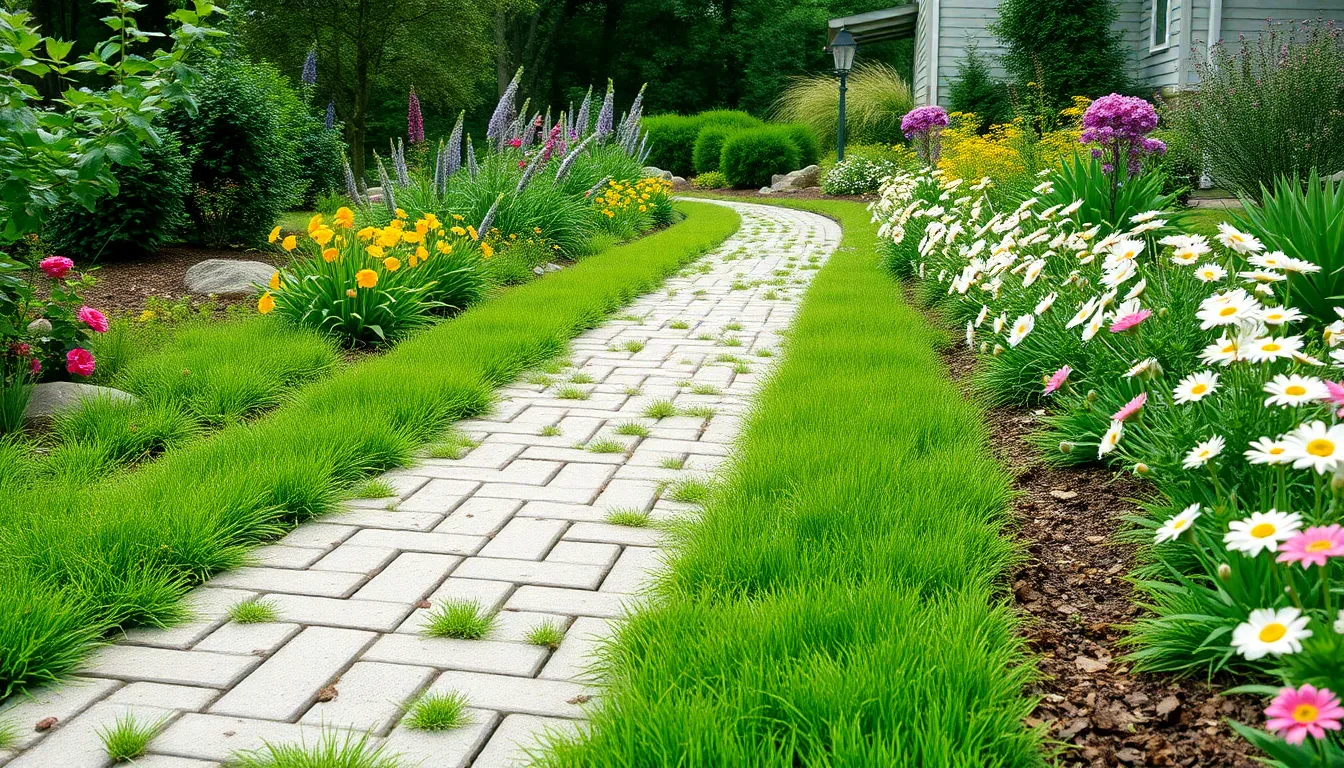
Sustainable walkway design takes center stage with permeable paver answers that transform how we manage stormwater runoff. These innovative systems allow rainwater to pass directly through the walkway surface, promoting natural hydrologic balance while creating beautiful pathways for your outdoor space.
Grass Grid Paver Systems
Combining stability with natural beauty, grass grid paver systems create walkways that look more like reinforced lawns than traditional hardscaping. Vegetation grows directly through the paver structure, offering excellent drainage while maintaining the strength needed for foot traffic.
Installation involves placing grid pavers over a prepared base, then filling the openings with soil and grass seed or plugs. The grass roots help stabilize the system while creating a soft, natural appearance that blends seamlessly with surrounding landscaping.
Maintenance requirements remain minimal since the grass naturally filters water and prevents erosion. We recommend choosing drought resistant grass varieties for areas with limited irrigation, ensuring your walkway stays green with minimal water input.
Gravel-Filled Paver Designs
Aggregate materials between pavers create highly effective drainage systems while adding textural interest to walkway designs. Gravel fills the gaps between individual pavers, allowing water to penetrate quickly into the ground below while preventing weed growth.
Stone selection impacts both function and appearance, with options ranging from fine crushed granite to larger decorative river rock. The gravel helps stabilize the pavers by preventing shifting while creating attractive contrast with the paver material.
Water flows easily through these designs, reducing surface runoff and promoting groundwater recharge. This approach works particularly well with natural stone pavers, where the gravel joints complement the organic shapes and textures.
Water-Permeable Installation Benefits
Stormwater management improves dramatically with permeable paver installations, reducing the volume entering drainage systems by allowing water to seep naturally into the ground. This process helps prevent flooding by slowly releasing water into the soil, mimicking how natural land absorbs rainfall.
| Benefit Category | Exact Advantage | Environmental Impact |
|---|---|---|
| Water Management | Reduces stormwater runoff by 30-50% | Prevents flooding and erosion |
| Pollution Control | Filters contaminants as water passes through | Improves groundwater quality |
| Durability | Withstands freeze-thaw cycles better than solid surfaces | Reduces maintenance costs |
| Network Support | Maintains natural water table levels | Supports urban drainage systems |
Pollution reduction occurs naturally as water filters through the paver system, removing contaminants before they reach groundwater supplies. The filtration process helps improve overall water quality while supporting sustainable urban drainage practices.
Durability proves exceptional across various climate conditions, with permeable systems often outlasting traditional solid walkways. The flexibility allows for natural ground movement without cracking, while the drainage prevents ice formation that can damage conventional surfaces.
River base flows benefit from these installations as they help maintain consistent groundwater levels throughout the year. This eco-friendly approach supports both immediate property drainage needs and broader watershed health.
Mixed Material Paver Walkways for Unique Style
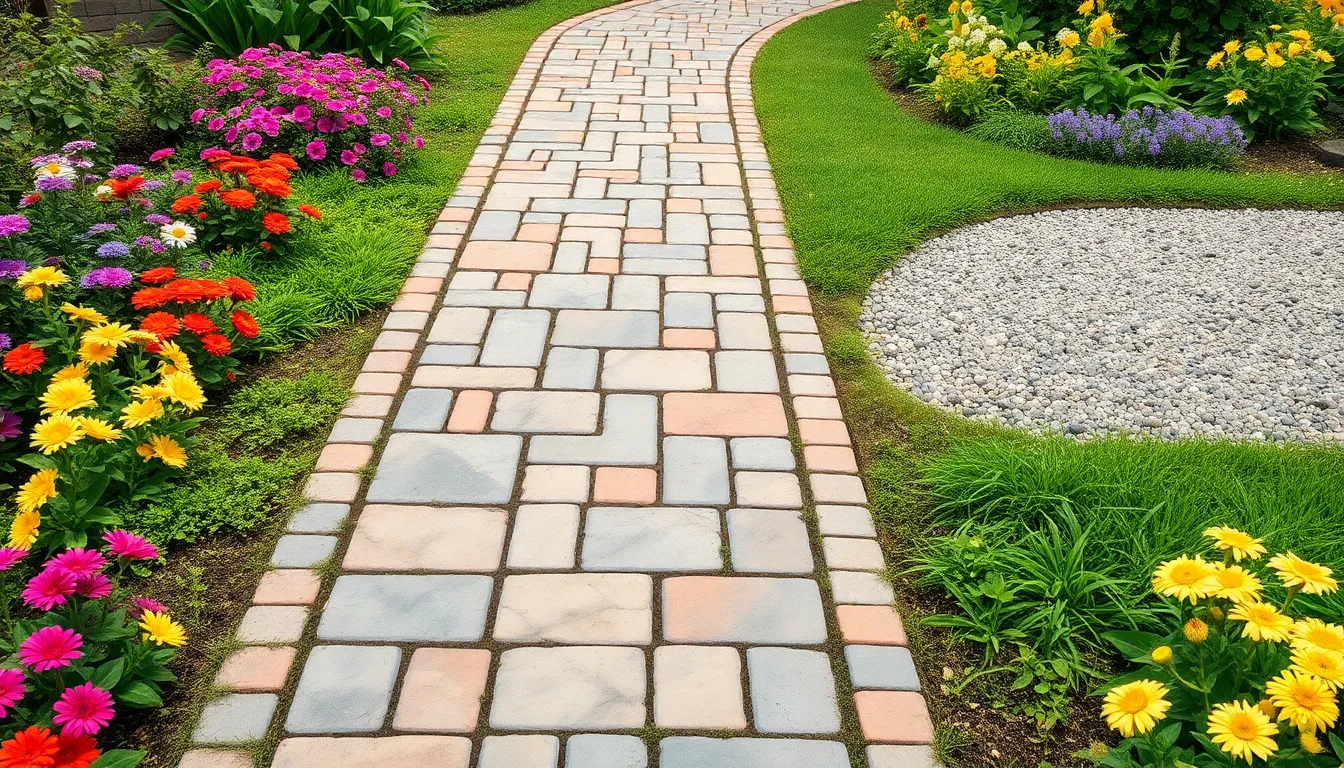
Combining different materials creates distinctive visual appeal and opens endless possibilities for custom walkway designs. We’ll explore how mixing materials allows you to create personalized pathways that perfectly complement your home’s architectural style.
Combining Stone and Brick Elements
Stone and brick pairings deliver an exceptional blend of natural texture and classic elegance that works beautifully across diverse architectural styles. We find that stone provides remarkable durability and rustic charm, while brick adds warmth and traditional appeal to any outdoor space.
Running bond patterns create smooth visual flow when combining these materials, making walkways appear longer and more streamlined. Basket weave designs introduce intricate texture that draws the eye and creates focal points along your pathway. Herringbone arrangements offer striking geometric patterns that work particularly well for both contemporary homes and historic properties.
We recommend alternating sections of each material to create rhythm and visual interest throughout your walkway design. Border applications using one material to frame the other can define edges while maintaining cohesive design flow.
Incorporating Wood and Paver Combinations
Wood and paver combinations introduce exceptional warmth and striking contrast that transforms ordinary garden paths into inviting outdoor features. We’ve discovered that wood planks interspersed with stone or concrete pavers create a perfect balance of rustic charm and modern sophistication.
Strategic placement becomes crucial when incorporating wood elements into your walkway design. We suggest using wood in low traffic decorative areas or as attractive borders, while positioning durable stone or concrete pavers in high traffic zones for longevity.
Reclaimed wood options paired with locally sourced stone create environmentally conscious walkways that reduce environmental impact. These eco friendly combinations offer unique character while supporting sustainable building practices. Temperature variations affect wood differently than stone, so proper spacing allows for natural expansion and contraction.
Adding Decorative Aggregate Accents
Decorative aggregates transform ordinary paver spacing into ever-changing design elements that enhance both visual appeal and practical functionality. We use colored gravel, crushed glass, and small decorative stones between pavers to create texture and improve drainage performance.
Strategic accent placement can highlight exact walkway sections and guide foot traffic naturally through your industry design. Colored aggregates allow you to introduce complementary hues that tie your walkway into surrounding garden elements and architectural features.
| Material Combination | Visual Style | Practical Benefits |
|---|---|---|
| Stone & Brick | Classic, rustic | Durability, timeless appeal |
| Wood & Pavers | Modern, warm | Comfort, eco friendly option |
| Pavers & Aggregate | Ever-changing, textured | Enhanced drainage, color variety |
Drainage improvements occur naturally when aggregate fills paver joints, allowing water to flow through rather than pooling on surfaces. We find that proper aggregate selection prevents weed growth while maintaining the clean appearance of your mixed material walkway design.
Curved and Meandering Paver Walkways for Garden Appeal

Curved walkways introduce a natural, organic flow that transforms ordinary garden spaces into visually captivating landscapes. These designs create gentle bends and irregular shapes that guide visitors through the garden while mimicking the soft lines found in natural environments.
S-Curve Pathway Designs
S-curve pathways use double bends to create ever-changing and visually interesting routes through outdoor spaces. These serpentine layouts encourage leisurely progression while increasing the perception of garden size and allowing for varied plantings along the pathway.
Benefits of S-curve designs:
- Increase visual interest by creating unexpected turns and focal points
- Expand the perceived size of smaller garden areas through extended pathways
- Allow for strategic placement of garden features like water fountains or seating areas
- Create natural viewing opportunities for different industry elements
We recommend using staggered or running bond patterns for S-curve installations since these arrangements allow pavers to align smoothly with the path’s bends without excessive cutting. The flowing nature of these designs works particularly well with natural stone pavers or brick materials that complement the organic aesthetic.
Circular Pattern Integration
Circular patterns serve as focal points in garden design by centering around patios or key industry features like fountains and seating areas. These designs create gathering spots and visual centerpieces that define functional zones while adding architectural interest to the industry.
Implementation techniques include:
- Using segmental pavers specifically designed for circular installations
- Arranging standard pavers in radial patterns from the center outward
- Creating multiple circular elements of varying sizes for visual rhythm
- Integrating circular designs with straight walkway sections for balanced flow
Circular installations work exceptionally well as transition points between different garden areas or as destinations along curved pathways. We find that these patterns add structure to informal garden designs while maintaining the organic feel of meandering walkways.
Organic Flow Planning Tips
Organic flow planning requires careful layout and installation techniques to achieve natural looking curved walkways. We recommend beginning the design process by laying out flexible hoses or using marking paint to outline gentle curves before installation begins.
Essential planning strategies:
- Start installation from the inside of curves and work outward to maintain proper alignment
- Minimize awkward gaps by carefully measuring paver placement along bends
- Integrate surrounding softscapes like flower beds and shrubs to amplify natural effects
- Select complementary paver colors and textures to enhance overall design unity
Proper integration with existing industry elements softens transitions between hardscapes and gardens while creating cohesive outdoor spaces. The key lies in balancing structured paver installation with the informal nature of curved designs to achieve both functionality and aesthetic appeal.
Illuminated Paver Walkways for Safety and Ambiance
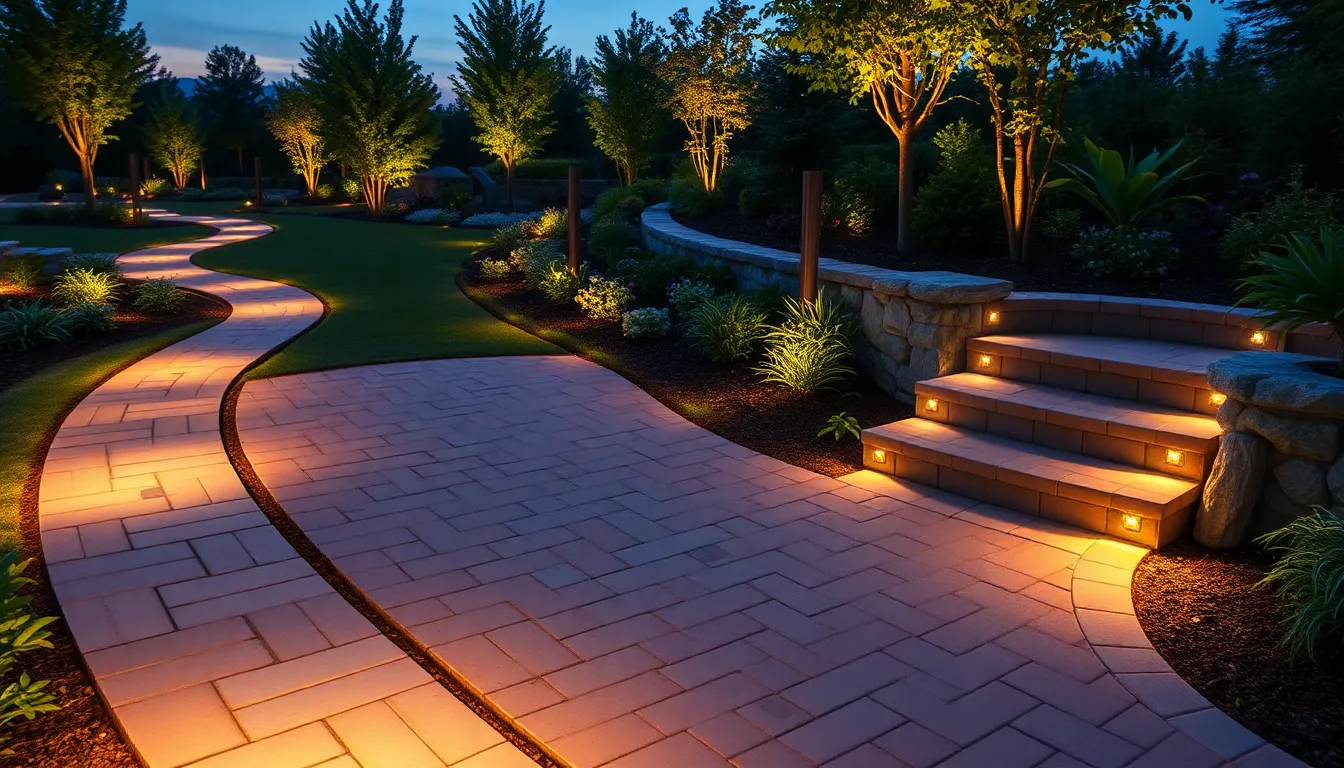
Illuminated paver walkways transform outdoor spaces by combining essential safety features with stunning visual appeal. We can create magical pathways that guide guests safely while adding enchanting ambiance to our industry design.
Solar-Powered Paver Lights
Solar-powered lights offer the perfect solution for walkway illumination without increasing electricity costs. These sustainable fixtures harness solar energy during daylight hours and automatically illuminate our pathways at night. Installation becomes incredibly simple since we don’t need electrical wiring or professional electrical work.
Embedded brick paver lights work beautifully in curved paths, providing soft illumination that highlights natural walkway curves while ensuring guest safety. We can choose from various sizes and brightness levels to match our exact design needs. Maintenance stays minimal since solar panels typically last for years with basic cleaning.
Cost savings make solar options particularly attractive for budget-conscious homeowners. Weather-resistant designs ensure reliable performance across different seasons and climates. We can easily relocate these lights if we decide to modify our walkway layout in the future.
LED Strip Integration Ideas
LED strips create modern, sleek lighting effects that enhance contemporary paver walkway designs. We can install these flexible lighting answers between pavers or underneath the surface for subtle, continuous illumination. Color-changing options allow us to customize the ambiance for different occasions or seasons.
Under-surface installation provides a clean, seamless appearance that doesn’t interrupt the walkway’s smooth lines. We can use weatherproof LED strips designed specifically for outdoor applications. Dimming controls let us adjust brightness levels based on the time of evening or exact needs.
Between-paver placement creates dramatic linear patterns that guide visitors along the intended path. Smart LED systems can be programmed to activate automatically at dusk or respond to motion sensors. We should choose low-voltage options for safety and energy efficiency.
Accent Lighting Placement
Strategic accent lighting placement enhances exact walkway features while maximizing both safety and visual impact. We can position lights at the base of steps to illuminate elevation changes and prevent accidents. Alternating lighted paver bricks create rhythmic patterns that naturally guide visitors toward entrances.
Curved section lighting requires careful positioning to highlight the walkway’s natural flow without creating harsh shadows. We recommend placing fixtures on the inside of curves to provide optimal illumination coverage. Low-voltage lighting offers flexibility in design placement while maintaining safe operation standards.
Glow-in-the-Dark Borders provide a unique approach that creates magical ambiance without requiring electrical wiring. These phosphorescent materials charge during daylight and emit soft light throughout the evening hours. We can combine multiple accent lighting techniques to create layered lighting effects that work together seamlessly.
Low-Maintenance Paver Walkways for Busy Homeowners
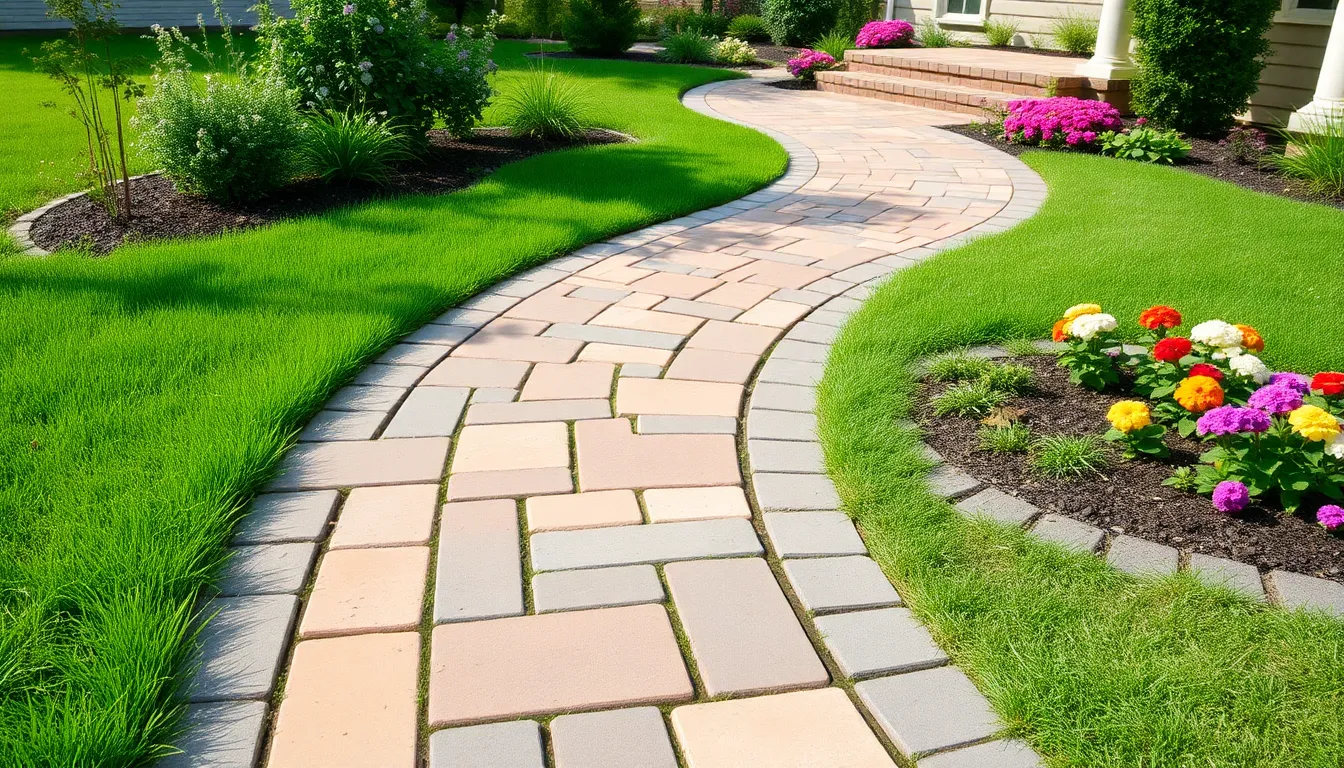
Busy homeowners often seek walkway answers that offer lasting beauty without demanding constant attention. We’ve identified the most effective strategies to minimize maintenance while maximizing the durability of your paver walkway investment.
Sealed Paver Surface Options
Sealing transforms your paver walkway into a protective barrier against stains, weather damage, and everyday wear. We recommend applying sealers every few years to maintain optimal protection and reduce cleaning frequency significantly.
Surface Protection Benefits:
- Stain resistance from spills and natural debris
- Weather protection against harsh seasonal conditions
- Reduced maintenance frequency and easier cleanup
- Enhanced color retention over time
Sealer finishes range from matte to glossy options, allowing us to customize the appearance based on your climate conditions and aesthetic preferences. Matte finishes work well in high traffic areas, while glossy sealers enhance the natural colors of decorative pavers.
Application Timing:
We suggest sealing new installations after 6-12 months of settling, then reapplying every 2-3 years depending on foot traffic and weather exposure. Proper sealing creates a protective film that makes routine cleaning as simple as hosing down the surface.
Weed-Resistant Installation Methods
Proper installation prevents weed growth from beneath and between pavers, eliminating the need for frequent weeding maintenance. We focus on comprehensive base preparation and advanced joint materials to create long lasting barriers.
Geotextile Fabric Installation:
Installing geotextile fabric beneath the base layer blocks soil migration and prevents weed seeds from germinating under your walkway. This barrier method stops problems at the source rather than treating symptoms after weeds appear.
Polymeric Sand Benefits:
Using polymeric sand between paver joints creates a hardened surface when activated with water. This specialized sand locks out weeds and pests while providing structural stability that traditional sand cannot match.
| Installation Component | Weed Prevention Method | Maintenance Reduction |
|---|---|---|
| Geotextile Fabric | Blocks soil and seed migration | Eliminates under-paver weeding |
| Polymeric Sand | Hardens to lock out growth | Reduces joint sand replacement |
| Proper Base Depth | Prevents settling and gaps | Minimizes paver shifting |
Joint Sand Maintenance:
Periodically adding joint sand keeps pavers tightly packed and prevents gaps where weeds might establish. Polymeric sand typically lasts 3-5 years before requiring replacement, compared to annual reapplication of standard sand.
Easy-Clean Paver Materials
Material selection dramatically impacts long term maintenance requirements, with certain paver types offering superior cleaning advantages. We evaluate each material based on durability, stain resistance, and cleaning simplicity.
Concrete Pavers:
Concrete pavers provide exceptional durability and clean easily with water and mild detergent for most maintenance needs. These pavers withstand heavy loads and harsh weather while allowing easy replacement of individual damaged units.
Natural Stone Options:
Natural stone pavers combine beauty with practical maintenance benefits, requiring only basic cleaning with water and gentle detergent answers. Stone surfaces resist staining naturally and develop attractive patina over time without requiring special treatments.
Rubber Paver Advantages:
Rubber pavers offer unique maintenance benefits including crack resistance, sound absorption, and simple cleaning by hosing or sweeping. Although less traditional in appearance, rubber materials excel in high traffic areas and challenging weather conditions.
| Material Type | Cleaning Method | Durability Rating | Replacement Ease |
|---|---|---|---|
| Concrete | Water + mild detergent | High | Individual unit replacement |
| Natural Stone | Water + gentle cleanser | Very High | Individual unit replacement |
| Rubber | Hosing or sweeping | High | Individual unit replacement |
Maintenance Schedule:
Regular maintenance consists of sweeping debris weekly, hosing down the walkway monthly, and using detergent answers for stubborn stains as needed. Each material provides distinct advantages that can be selected based on your regional climate, aesthetic preferences, and exact maintenance requirements.
Budget-Friendly Paver Walkways for Cost-Conscious Projects
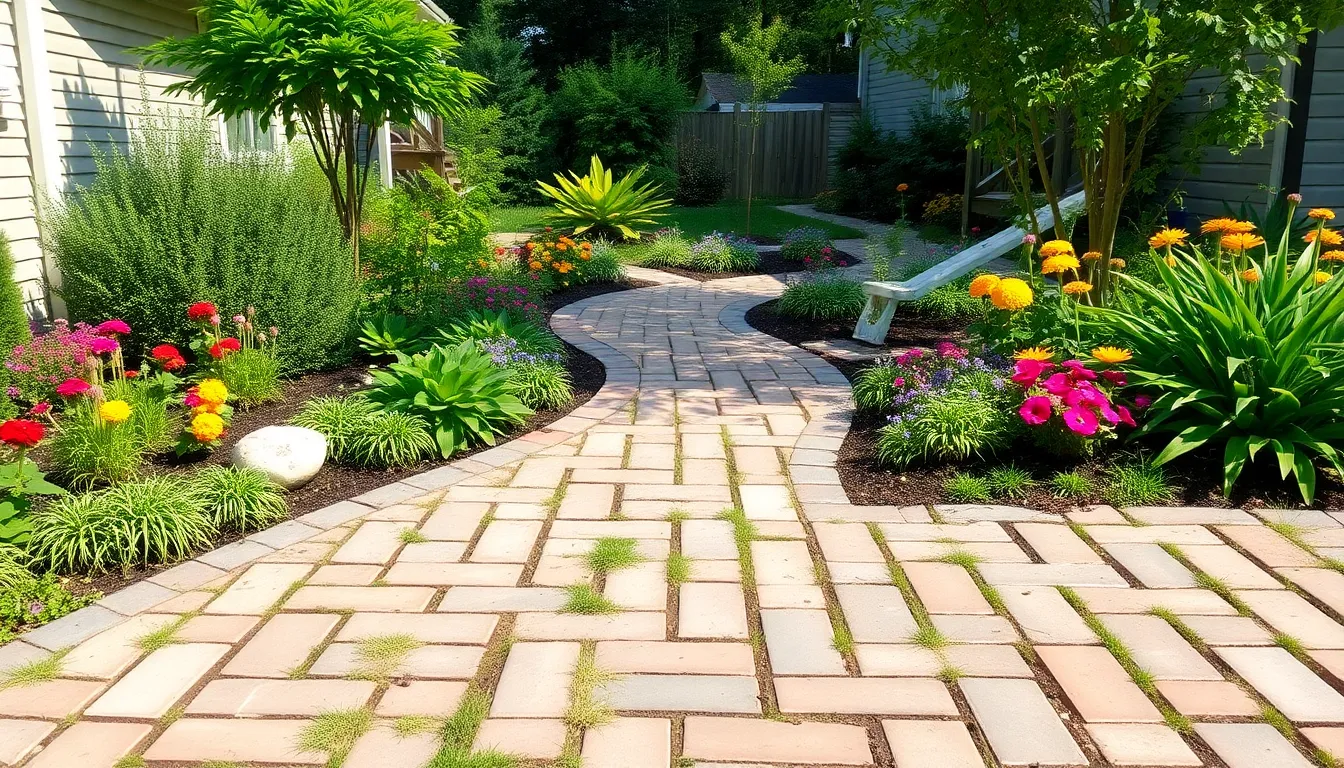
Creating stunning walkway designs doesn’t require very costly when you know which materials and methods deliver maximum impact for minimal investment. Smart material choices and strategic installation approaches can reduce costs by up to 60% compared to professional installations.
Recycled Material Options
Salvaged bricks offer exceptional value for creating character-rich walkways at fraction of new material costs. These weathered materials require only basic cleaning before installation and provide authentic charm that new pavers simply can’t match. Reclaimed wooden pallets present another sustainable choice, requiring minimal processing through sanding and sealing to transform discarded materials into rustic pathway elements.
Concrete remnants from construction sites or demolition projects provide durable stepping stones when properly shaped and finished. We’ve found that mixing different recycled materials creates unique visual textures while maintaining budget consciousness. Surplus brick from local construction projects often sells for 30-50% less than retail prices and adds instant character to garden pathways.
Pallet wood planks create eco-friendly walkways when disassembled, sanded smooth, and sealed against weather damage. These reclaimed materials not only reduce environmental impact but also deliver distinctive rustic appeal that complements natural garden settings. Local demolition companies frequently offer mixed lots of salvaged materials at important discounts compared to new purchases.
DIY Installation Tips
Site preparation forms the foundation of successful budget walkway projects, starting with turf removal and soil compaction to create stable base conditions. Proper gravel base installation requires 2-3 inches of compacted material followed by leveling sand layer for optimal paver placement. We recommend renting basic tools like plate compactors rather than purchasing equipment for single-use projects.
Dry-laid installation methods eliminate mortar costs while providing flexibility for future adjustments or repairs. This technique works exceptionally well with concrete pavers, brick, and flagstone materials when installed over properly prepared sand base. Pattern planning on paper before installation prevents costly material waste and ensures professional-looking results.
Wooden pallet walkways require strategic plank placement with small drainage gaps to accommodate expansion and water flow. Basic carpentry skills and standard tools handle most installation challenges, making this approach accessible to beginning DIY enthusiasts. Sealing pallet wood with appropriate exterior finishes extends lifespan and maintains appearance through multiple seasons.
Affordable Paver Alternatives
Pea gravel pathways offer quick installation at minimal expense while providing excellent drainage and natural appearance. These loose materials require simple edging installation to maintain defined pathway boundaries and prevent spreading into surrounding garden areas. Gravel options come in various colors and sizes, allowing customization without premium pricing.
Mulch walkways deliver soft, natural surfaces that complement organic garden designs while remaining budget-friendly throughout installation and maintenance. Wood chips, bark mulch, and shredded leaves create comfortable walking surfaces that integrate seamlessly with planted areas. Regular replenishment maintains appearance and functionality at minimal ongoing cost.
Concrete step stones spaced strategically reduce material requirements while creating interesting pathway rhythm through garden spaces. These affordable elements work effectively when combined with decorative borders or ground cover plantings between stones. Mixing inexpensive flagstones with step stone placement further reduces installation time and material costs while maintaining visual appeal.
Conclusion
We’ve explored an incredible range of paver walkway possibilities that can transform any outdoor space into something truly special. From timeless brick patterns to modern concrete designs and eco-friendly permeable options there’s a perfect solution for every home and budget.
The beauty of paver walkways lies in their versatility – whether you’re drawn to the rustic charm of natural stone the sleek lines of contemporary concrete or the innovative appeal of illuminated pathways you can create something uniquely yours. Mixed materials curved designs and low-maintenance options ensure your walkway will enhance your property for years to come.
Your outdoor space deserves a walkway that reflects your personal style while providing lasting functionality. With the right design approach and materials you’ll create an inviting path that welcomes guests and adds important value to your home.
Frequently Asked Questions
What are the main benefits of installing paver walkways?
Paver walkways enhance both functionality and aesthetic appeal of outdoor spaces. They significantly boost curb appeal and property value while providing durable, attractive pathways through your landscape. Pavers offer versatility in design, durability across various weather conditions, and can accommodate different budgets from DIY projects to luxury installations.
Which paver materials are best for durability and low maintenance?
Concrete pavers, natural stone, and bluestone offer exceptional durability with minimal maintenance requirements. Concrete pavers provide clean lines and easy cleaning, while natural stone like flagstone offers rustic charm and weather resistance. Proper sealing and installation with geotextile fabric and polymeric sand further reduce maintenance needs.
How do permeable paver walkways benefit the environment?
Permeable paver walkways allow rainwater to pass through the surface, reducing stormwater runoff and promoting natural water filtration. They help improve groundwater quality, prevent flooding, and maintain natural hydrologic balance. These eco-friendly systems also offer excellent drainage while supporting vegetation growth in grass grid designs.
What are some budget-friendly paver walkway options?
Budget-friendly options include recycled materials like salvaged bricks and reclaimed wooden pallets, which offer character at lower costs. DIY installation using dry-laid methods reduces labor expenses. Alternative materials like pea gravel and mulch walkways provide quick, affordable installation while maintaining natural appearance and functionality.
How can I add lighting to my paver walkway?
Solar-powered lights offer sustainable, easy-to-install illumination with minimal maintenance. Embedded LED strips and brick paver lights create modern lighting effects. Accent lighting enhances safety and aesthetics, while glow-in-the-dark borders provide unique, wiring-free solutions. Layered lighting effects combine multiple options for enhanced visual appeal.
What design patterns work best for different paver materials?
Brick pavers work well with running bond, herringbone, and basket weave patterns. Natural stone looks best with irregular, organic layouts that blend with landscapes. Concrete pavers suit geometric patterns with clean lines and right angles. Mixed materials can incorporate various patterns like staggered bonds for curved walkways.
How do I maintain my paver walkway?
Regular maintenance includes sweeping debris and hosing down the surface. Seal paver surfaces periodically to protect against stains and weather damage. Use polymeric sand in joints to prevent weed growth. For natural stone, occasional re-sealing maintains appearance and durability while preventing moisture damage.
Can I combine different materials in one walkway design?
Yes, mixed material walkways create distinctive visual appeal. Popular combinations include stone with brick for natural texture and classic elegance, wood with pavers for warmth and contrast, and decorative aggregates like colored gravel for enhanced drainage and aesthetics. Strategic material placement ensures durability and visual balance throughout the design.


